By Casey Sullivan, Vince Han, and Perry Blazian
Oct 2019
Training, Attention, and Chatbots
 It is common for world class, professional athletes to employ not one, but several coaches and advisors to help them reach their elite goals. For example, a professional marathoner might assemble a team made up of a running coach, strength coach, nutritionist, massage therapist and an agent. If this marathoner is already endowed with extraordinary endurance and speed, why the need for a full team of coaches and advisors and specialists to reach success?
It is common for world class, professional athletes to employ not one, but several coaches and advisors to help them reach their elite goals. For example, a professional marathoner might assemble a team made up of a running coach, strength coach, nutritionist, massage therapist and an agent. If this marathoner is already endowed with extraordinary endurance and speed, why the need for a full team of coaches and advisors and specialists to reach success?
Fundamentally, success requires constant attention; success is made up of many choices over time, not just one choice at one time. And the journey to success is fraught with obstacles often requiring skills we have yet to fully develop, as well as a high level of motivation, which is hard to maintain.
This dynamic is no different for employees when working on their personal and professional development. It would be a luxury if employers could afford to employ a team of expert coaches and advisors to help guide employees to achieve more success in their jobs. A lucky few may be surrounded by outstanding leaders and supportive colleagues who invest both the time and energy to help, but the vast majority of employees are often left largely to themselves to navigate through the journey of personal development.
Companies invest thousands–if not millions–of dollars into their training programs, eager for their employees to apply that training to day-to-day business practices. However, for a fraction of the investment of the initial training companies could add a reinforcement chatbot to this scenario and change the result entirely. According to Psychotactics.com the normal 20% retention rate more than triples to 75% by simply dedicating practice time. Trainers may encourage this practice by following up individually with participants, but in most cases that’s neither practical nor scalable. This is where a chatbot can make all the difference.
Traditionally, email reminders have been the primary channel to push out reinforcement messages to participants. Ask any instructional designer: getting a learner to pay enough attention to an email follow-up is as hard as getting a teenager to put their cell phone down during dinner. Chatbots are emerging as an effective tool to continue the conversation.
What is a chatbot?

Chatbots are all around us. Even if you haven’t interacted with one directly, odds are good you’ve heard stories about well known chatbots like Alexa, Siri, or Google Assistant misinterpreting commands that leave users helpless and humored. But our chatbot usage goes much deeper than that, providing often unnoticed automated help and support.
Breaking the word down, “chat” and “robot” further explain the idea of a “chatbot.” A chatbot is a computer program (robot) capable of carrying an informal conversation (chat) with a person. Chatbots allow for engaging conversations to occur through voice and text. Basically, a chatbot is an automated, yet personalized, conversation between software and human users.
Programmed to anticipate human responses, a chatbot automates communication for an assortment of applications, with an equally vast variety of benefits; not only are bots totally unbiased (making them completely cool-headed in even the tensest customer service situations), they use the most current and relevant communication channels to contact users.
What are chatbots good for?
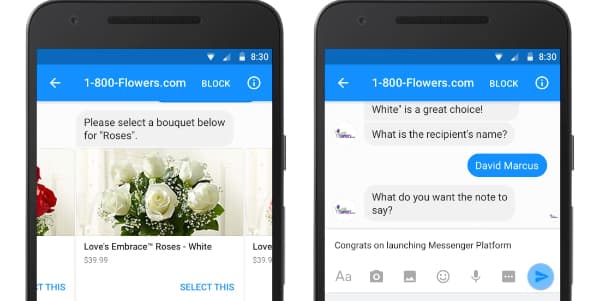
The most common uses of a chatbot in today’s technology landscape are for consumers. Good examples of valuable customer facing chatbots are easy to find. For example, the Expedia chatbot on Facebook Messenger helps you book a hotel room, Taco Bell’s Tacobot allows users to order a taco via a chat window on their website, and the on-demand text message concierge called Magic, which can book you a hotel room and order you a pizza.
Another example is BB (BlueBot), KLM Royal Dutch Airline’s chatbot on Facebook Messenger. BB’s main role is to assist the company’s team of humans working in live support as they interact with over 16,000 customers weekly, reported by MarTech Today. BB was designed to help keep KLM’s passengers up-to-date with flight information and even assist with booking tickets. BB was able to engage with over half a million customers in its first six months, sending close to two million messages. Most people simply want correct, up-to-date information, no matter whether the answers are automated or personal. Chatbots like BB give consumers the information they need quickly and easily, all while being cost-effective for the businesses that deploy them.
Chatbots are an excellent resource for the front line of any customer service platform. They excel at providing help desk assistance such as providing answers to FAQ/database based inquiries.
Employee-facing chatbots offer numerous advantages for businesses. Chatbots are positioned perfectly to perform the function of employee training, like onboarding new employees. They can even carry out compliance training for topics such as safety, ethics, or diversity and inclusion. Chatbots also are excellent resources to provide access to an internal help desk, allowing employees to access the information they need at any time of day.
The evolution from using a chatbot as a consumer engagement tool to using a chatbot to facilitate employee learning and development is natural since a good chatbot can communicate with learners in the same way friends and colleagues do. A learner won’t ignore a message from a dear friend, neither will they ignore one from a chatbot—if the chatbot is smart, friendly, and adds value to the learner’s day.
How do chatbots work?
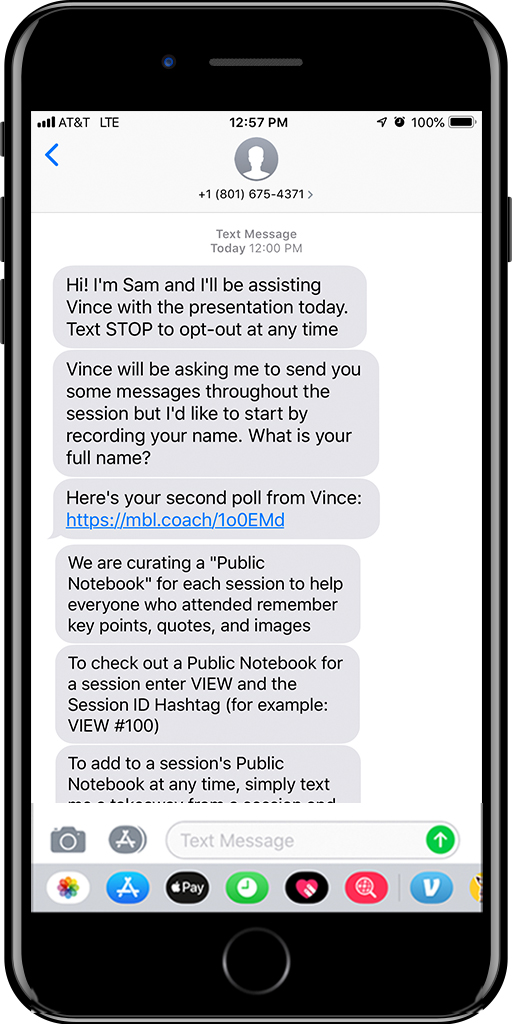 Chatbots are developed to understand and communicate with users using a variety of automation technologies including Artificial Intelligence (AI), Natural Language Processing (NLP), or a Rules Engine.
Chatbots are developed to understand and communicate with users using a variety of automation technologies including Artificial Intelligence (AI), Natural Language Processing (NLP), or a Rules Engine.
Artificial Intelligence (AI) has been defined as “a system’s ability to correctly interpret external data, to learn from such data, and to use those learnings to achieve specific goals and tasks through flexible adaptation” by Kaplan and Haenlein. For many, AI is associated with learning and problem solving done by a computer.
Natural Language Processing (NLP) is technology that makes it possible for AI-powered computer programs to understand human language. Good examples of this are the virtual assistants that are found in cell phones and smart home gadgets.
A rules engine will break down text messages into individual components to interpret them according to predefined rules. A chatbot using a rules engine will then determine a suitable response, drawn from a Knowledge Base or continuing a prepared path of conversation.
All chatbots utilize these technologies in some form to execute the automation designed in the chatbot’s purpose and personality.
Where can chatbots be found?
There are numerous chatbots on platforms like Facebook Messenger and sitting on many of your favorite e-commerce and SaaS sites. Text-based chatbots allow for one-on-one conversations between you and the bot. Commonly these conversations occur via SMS, Facebook Messenger, Slack, and in chat windows on websites. These text-based interactions can provide customer service for software, provide product recommendations, inform you of weather and news, or even conduct transactions for you.
Modern chatbots come in many different forms and functions. Chatbots are also commonly found as productivity tools. The Slack team now has their own chatbot platform too, with a host of applications. They recently teamed up with PayPal to create a bot that facilitates money transfers through the Slack platform to expedite exchanges between individuals and teams.
Other chatbots of today include the well known personal assistant types—Siri, Alexa, and Google Assistant. These chatbots provide value by dialing calls for you, setting appointments, sending messages, and looking up information for you. Living in “smart” devices like your phone, speaker, TV, tablet and even your thermostat, these personal assistant chatbots are designed to make your life easier.
How long have chatbots been around?

The ideas for chatbots and computer intelligence date back to 1950. An English scientist named Alan Turing published an article in which he proposed the question “Can machines think?” Additionally, his article lays out the basis for the Turing test, a way to measure whether you are speaking to a human or a machine.
By proposing this standard for machine intelligence, Alan Turing threw down a challenge to all computer scientists to pass his test. In 1966 Joseph Weizenbaum, working out of the MIT AI laboratory, created ELIZA. Though ELIZA failed the Turing test, Weizenbaum laid the foundation for chatbot (then referred to as “chatterbot”) structure such as keywords, specific phrases and pre-programmed responses.
A few years later in 1972 Kenneth Colby, an American psychiatrist working out of the Stanford AI laboratory, developed PARRY, a chatbot that simulated a person with paranoid schizophrenia. In testing PARRY with psychiatrists, just under half were able to identify the difference between PARRY and a real person.
Chatbot development accelerated in the 1990s with the development of Dr. Sbaitso in 1992 and A.L.I.C.E. in 1995. Dr. Sbaitso was an AI speech program built for MS-DOS computers that assumed the role of a psychologist and showcased a digitized voice. ALICE was a natural language processing (NLP) bot. She used sophisticated rules to match human input to carry out a conversation.
Modern chatbots
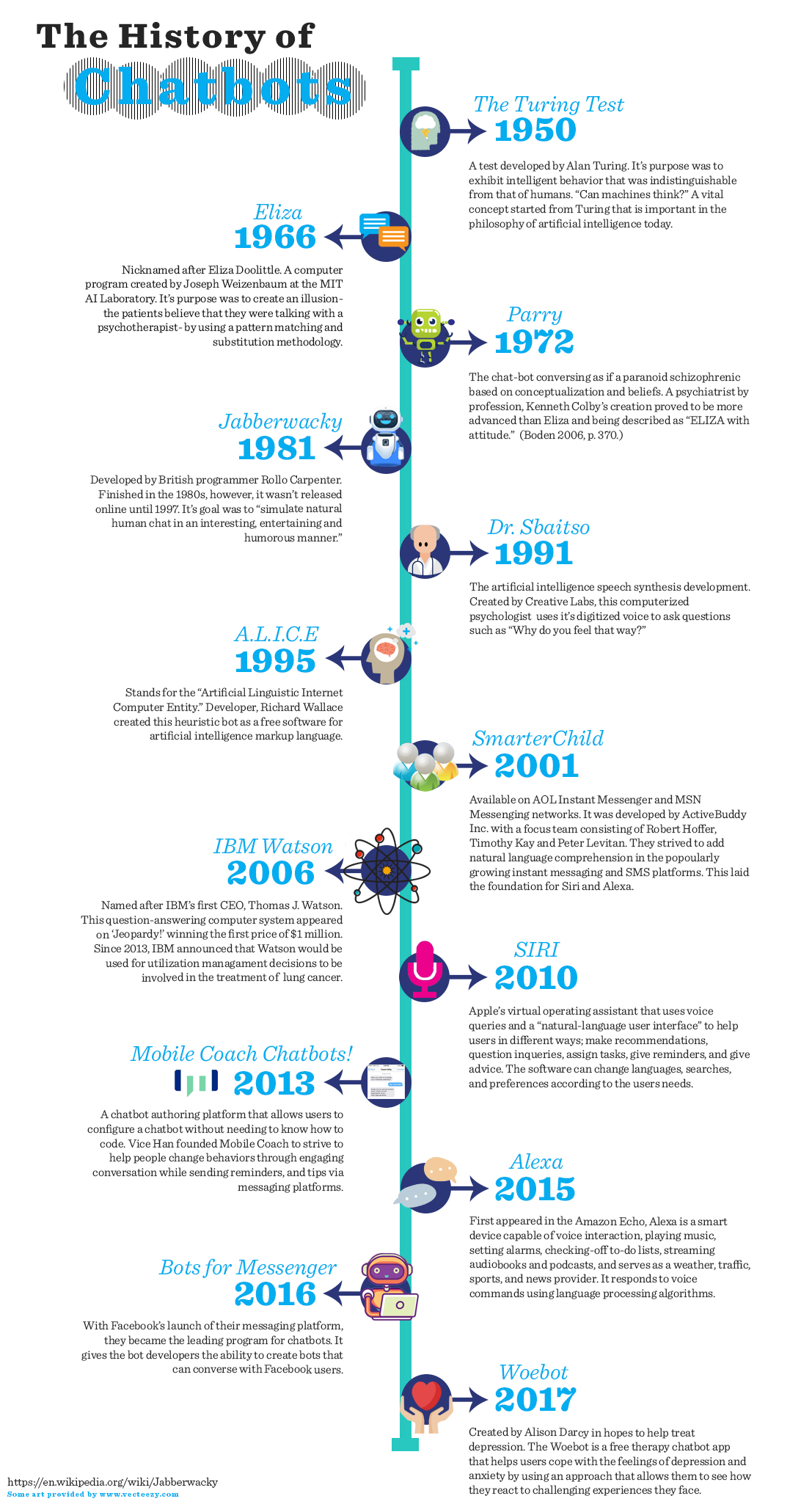
Originally developed for the AOL messaging platform, SmarterChild was released in 2001. SmarterChild engaged users in conversations that were entertaining and personalized. It quickly gained wider distribution, soon working on MSN Messenger and via SMS. In many ways, SmarterChild was the precursor to Alexa and Siri.
The year 2006 brought the big tech companies into the chatbot realm with IBM’s Watson. Many of us recall Watson playing and winning at Jeopardy against champions Ken Jennings and Brad Rutter in 2011. Watson’s AI and NLP base has since been commercialized to process and reveal insights from large data sets.
In 2013, Mobile Coach released its first chatbot, Coach Alba, that helped users achieve fitness and weight loss goals. The technology in Coach Alba was developed and expanded to become a full-featured chatbot authoring tool, which has grown into the Mobile Coach Platform. Since then, Mobile Coach has continued to develop and innovate chatbot designs.
In the last 10 years, some of the best known chatbots have been personal assistants from tech giants like Apple (Siri – 2011), Google (Google Now – 2012), Amazon (Alexa – 2015), and Microsoft (Cortana – 2015). These voice based chatbots use NLP and sophisticated rules to perform a variety of actions and commands on multiple platforms (mobile devices, smart speakers, thermostats, etc).
Gwyn, 1-800-Flowers’ chatbot launched in 2016, was among the first chatbots on the Facebook Messenger platform. By opening up the Messenger platform to bot development Facebook launched a frenzy of bot development. In the years since hundreds of thousands of bot have been built on the platform.
In 2017, WoeBot launched as a cognitive behavioral therapy (CBT) chatbot. Woebot is designed to provide CBT to users. In an academic study of WoeBot’s effectiveness, it was found that WoeBot significantly reduced depression in users over the study period. The study concluded that “conversational agents appear to be a feasible, engaging and effective way to deliver CBT.”
Chatbots are continually getting smarter and more capable. Use cases from personal assistants, customer service, commerce transactions, CBT, and learning all continue to expand and gain greater acceptance into society.
Why Chatbots for Learning?

Most of us are familiar with the term, “the learning curve.” We typically use this phrase when what we are learning is difficult and requires an extended period of time. For example, “I just started a brand new career and there is a big learning curve” or “I’m moving to a new country and tackling the learning curve of a new language.”
The term, learning curve, refers to the fact that truly learning something requires time and experience. Most depictions of the learning curve show a smooth curve like the one in Figure A.

However, all too often, our learning curve ends up looking more like the one in Figure B.
The unfortunate reality for many is that while we often start out with a bang, we fail to make learning stick and lose any ground we may have gained. This version of the learning curve can also resemble how our New Year’s resolutions sometimes go!
In actuality, when learning does effectively happen and sticks for good, it ends up looking something like the curve in Figure C.

Learning a skill or proficiency is a journey comprised of many ups and downs; we make some progress and then forget or slip up and need a nudge to regain momentum. Think about the toughest new skills or habits you’ve had to adopt in your life. It is likely that your journey most resembled this jagged version of the learning curve.
Whether you are a professional marathoner or toiling away in your job, understanding the dynamics of real learning is key to success. And employers need to understand these dynamics in order to create an environment and provide tools to help each employee navigate through their individual learning curves.
The Fundamental Challenges
There are several fundamental challenges that employees confront when tackling their respective learning curves:
Maintaining Motivation – When employees set professional goals, it can be common for them to struggle with staying motivated once the initial enthusiasm wears away. Motivation is the fuel that powers the journey up the learning curve and so without it, you won’t see results.
Skills Gap – Some employees could be highly motivated, but if they lack the skills and the know-how required, they will also face difficulty staying on the steep learning curve. Part of the successful navigation up the learning curve should include identifying what skills are lacking and forming a deliberate plan to help develop those skills.
Managing Externalities – Life can have a knack of throwing obstacles in our way, many of which are beyond our control. Health issues, family problems, relationship problems with colleagues, transportation difficulties, and other stresses can overwhelm us as we try to conquer the learning curve.
Staying Connected – In our age of unlimited distractions, it can be extremely difficult to stay consistently connected to the hearts and minds of our employees. Inundate them with too many messages and they’ll revolt, hit them up with too few and you become irrelevant.
Engagement Barrier – The inherent challenge with any app or website is that they are a destination, and therefore success is contingent on being able to get users to consistently return and engage. All too commonly, after the initial burst of excitement, app and website activity can fall off quickly with only a small percentage of users staying actively engaged.
The Choose to Engage Barrier
 Enterprises want to leverage proven app techniques to engage their target audience but oftentimes their analysis is comparing apples to oranges. The average adult in the US has 37 apps on their phones but 80% of their usage is dedicated to just 3 of those apps. And what are those apps? Most commonly, Facebook, Chrome and YouTube. These are not productivity tools but personal, “time-wasting” tools where the main value proposition is anti-boredom, not self-improvement.
Enterprises want to leverage proven app techniques to engage their target audience but oftentimes their analysis is comparing apples to oranges. The average adult in the US has 37 apps on their phones but 80% of their usage is dedicated to just 3 of those apps. And what are those apps? Most commonly, Facebook, Chrome and YouTube. These are not productivity tools but personal, “time-wasting” tools where the main value proposition is anti-boredom, not self-improvement.
For productivity and business-related tools, the requirement of the user needing to choose to login to check their next task is too much to ask for when competing with YouTube videos, social media alerts and the like. We call this the “Choose to Engage Barrier.”
This type of engagement attrition is all too familiar for many. And what can make it even more infuriating is that users themselves will assuredly claim that they want to use the tool and they readily recognize the need for it to accomplish the goals they have for themselves.
In fact, we know that most users want to learn and want to change their behavior which is why they download and engage with an app in the first place.
They want to do it, they just don’t.
Frictionless UX
The challenge of engaging learners post-training is typically not grounded in a lack of desire or motivation on the part of the learner. In fact, learners want to apply what you teach them in order to improve job performance and, in many cases, have the training benefit their personal lives as well. The challenge is actually in finding time to work on any post-training review, reflection, or skills practice. In the day-to-day hustle and bustle of corporate life, rarely do people block out time on their calendar for “post-training review” (although applying learning into someone’s daily routine should be a more natural integration anyway).
The post-training engagement options mentioned above of email, training manuals, learning apps, etc. all come with some form of friction–small but formidable obstacles standing in the way between the learner and the content you want them to consume. Email inboxes are cluttered and overwhelming, apps require usernames and passwords quickly forgotten, and all these solutions demand more time than the learner perceives they have to give.
Chatbots that engage learners on a common messaging platform like SMS or WhatsApp (there are many others) have the distinct advantage of being on the channel that learners pay the most attention to. Why? Because these are the channels where their family and friends are communicating with them. In the USA, for example, industry reports state that 98% of text messages are read, an impressive statistic when compared to email read rates.
Asking a learner to add a chatbot to their list of contacts is a markedly easier task for them cognitively than having to install and learn how to use an app. Asking a learner to exchange messages with a chatbot is as easy as asking them to text a new colleague. This ease of use translates into the most frictionless way to reach and engage your learner population.
Channel Options
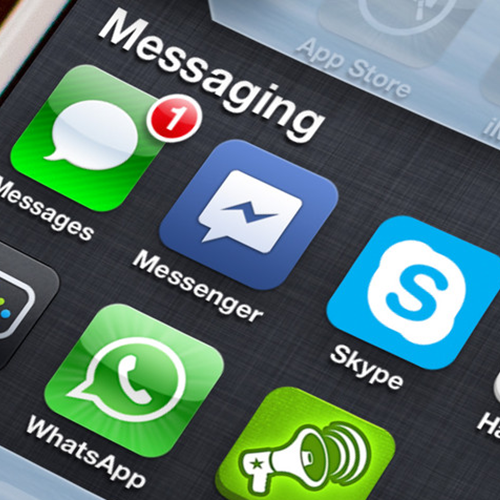 Common messaging apps vary from country to country. In many Western countries, SMS still tends to reign supreme although younger generations have flocked to social media apps like Instagram, Snapchat, and others. In other areas of the world, messaging apps like WhatsApp, WeChat, LINE, Telegram, Kakao, Viber, and others have amassed millions of users seemingly overnight.
Common messaging apps vary from country to country. In many Western countries, SMS still tends to reign supreme although younger generations have flocked to social media apps like Instagram, Snapchat, and others. In other areas of the world, messaging apps like WhatsApp, WeChat, LINE, Telegram, Kakao, Viber, and others have amassed millions of users seemingly overnight.
Almost all popular messaging apps allow for chatbots, although each may dictate and police automation in different ways, mostly to limit abuse by spammers and aggressive marketers. The big advantage of putting your reinforcement chatbot on one of these messaging apps is simply to make it easy for your learners to find and engage with it.
Keep in mind, however, that with such personal access to the learner’s day-to-day life, the quality of the chatbot experience becomes paramount (see section below). People like to control who gets access to their most personal spaces, and while work-related exchanges are granted some level of access, it is reserved for things that are either urgent or feel especially useful.
Some organizations may be reluctant to have work-related experiences on messaging apps due to security or workforce management considerations. In cases like this, those organizations may have some form of mobile communication such as Yammer, Slack, Microsoft Teams, etc. With chatbot popularity on the rise, these platforms should allow for chatbot integration, which can be another alternative to consider.
Instructional Design
When people think of chatbots, they tend to think about populating some knowledge base with FAQs and applying machine learning to match user inquiries to the appropriate answer. When it comes to a mobile-based chatbot for training reinforcement, however, the design of the chatbot takes on a whole new level of sophistication. You suddenly have the ability to design your chatbot to proactively send messages to learners in the form of reminders, nudges, quizzes, learning exercises, and more.
This ability to push content and instigate a learning interaction is powerful but also requires sensitivity so as to not annoy, overwhelm, or confuse learners. For hourly or shift workers, you need to be sensitive to the timing of the messages. In all cases, thought should be applied to the personality of the chatbot, the tone of messages, the frequency of messages, and for how long you want the interactions to last (e.g. how many weeks or months).
The good news is that for learning professionals, the #1 skill is instructional design! So applying what we know about how people learn and how to encourage them to think about and apply lessons is something we are naturally going to excel in. Sure, the medium of a chatbot might be new to us, but some initial trial and error will quickly help instructional designers create chatbot experiences as adeptly as they do e-learning courses.
Key Chatbot Design Advantages
Designing a chatbot is as much an art as it is a clever utilization of technology, and presents a new, compelling challenge for instructional designers. After all, you are trying to get a learner to engage in an ongoing conversation with a computer! Depending on the context of the training program or support initiative, a chatbot can be designed to focus on a number of different tasks:
Providing reminders
Reminders are only effective if they can cut through the clutter of the day and actually reach learners. Chatbots that integrate with popular messaging channels allow reminders to drop right in among a learner’s regular conversations and reach them where they’re already comfortable. Reminders can also be specifically timed to arrive at times when learners need them most. A friendly message from a chatbot that reminds the learner of concepts learned will work to mitigate the forgetfulness curve. It creates another link in the memory chain, ensuring that the concept is better remembered and, in the future, better applied.
Tracking goals
 When training workshops end with the participant making some meaningful goal, a chatbot can be designed to be an effective accountability partner. Being held accountable by another person (in this case, a chatbot), makes an individual 33% more likely to actually achieve their goal, according to a study conducted at Dominican University in California. A chatbot can send regular reminders, ask about progress, and provide resources for a participant.
When training workshops end with the participant making some meaningful goal, a chatbot can be designed to be an effective accountability partner. Being held accountable by another person (in this case, a chatbot), makes an individual 33% more likely to actually achieve their goal, according to a study conducted at Dominican University in California. A chatbot can send regular reminders, ask about progress, and provide resources for a participant.
Introducing new concepts
The limited time we are given to host a learner in a workshop or course means we are limited with the amount of valuable content we can teach. With a chatbot extending the conversation, sometimes months at a time, an instructional designer can add new concepts to the learning experience and deliver them weeks and even months after the classroom experience has concluded.
Assessing transference
Assessments determine how well content is absorbed by learners. This kind of quizzing and testing can be delivered via chatbot, after a training or seminar, to ensure that those who have participated in the course have not just listened to, but really learned the topics presented. Chatbots can easily offer binary choice (e.g. true/false) and multiple choice questions to measure learning progress, and collect feedback in the form of open-ended responses from learners.
Supporting continued performance
In a perfect world, one could hire a coach for every learner to act as a 24/7 resource; a chatbot is the next best thing. You can train a chatbot to be able to answer learner questions on-demand–helping them to apply the lessons in the moment when they need it the most.
Gathering data on ROI
Instructional designers are constantly asked to deliver an ROI (return on investment) calculation on the training they build and deliver. The challenge with this has been a lack of means to gather data from learners on whether they are applying the training. A chatbot solves this problem by collecting information from the learner for months after the training. This can include asking users for self-assessments and concrete examples of application. Data can be collected, analyzed, and delivered in a format that shows how well participants apply training even months after a course is over.
Where chatbots struggle
Like any technology, chatbots have their limits. Chatbots struggle when they come across requests that are outside of what they are designed to do. You won’t have much luck asking your weather chatbot to help you track a package. Likewise, Amazon’s well-known chatbot Alexa can’t help you with your credit card questions—you need the American Express chatbot for that. Chatbots cannot improvise like humans can, so they do not do well operating beyond what they are programmed to do.
When can I use chatbots?
While chatbots are commonly known for customer support, that’s just one way to utilize this growing technology. Enabling a chatbot on a common mobile messaging platform like SMS or WhatsApp creates the ideal user experience for a variety of learning and development use cases.
Learning Reinforcement
An age-old dilemma for Learning and Development (L&D) professionals has been how to engage a learner after they have attended a workshop or an e-learning course. The reason to keep a connection with the learner is clear–unless a learner continues to think about, practice, and review what is learned, they will forget course material and the investment of the training is all but wasted.
Most attempts at continued learner engagement have had limited effect; emails are left unread, glossy training manuals collect dust, push notifications on learning apps are disabled, and there isn’t enough time in the day for a human coach to follow up with each individual learner.
If you want to keep the conversation going that you start in a training course, what better way to do that than with a technology that is built around having conversations? Chatbot technology allows you to scale personalized follow-up conversations across the globe to thousands of people–even while you sleep!
Try it out:
- US SMS: Say Hi to (801) 609-3592
- Teams: Click here and say Hi
- Web: Click here
- Slack: Click here to join the Slack Workplace, then click here and say Hi
Leadership Development
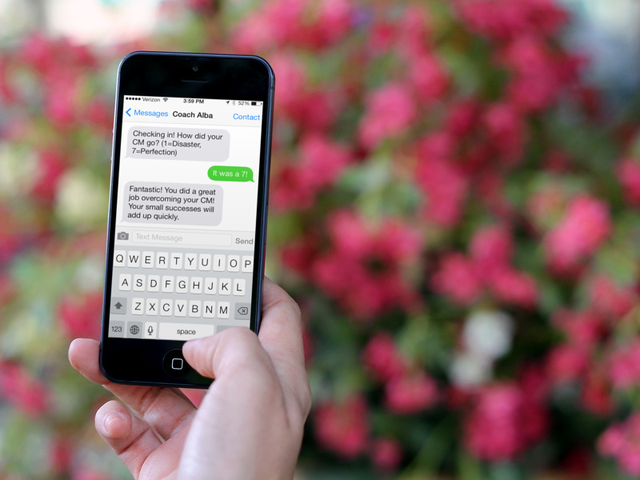 Leadership skills are essential in any organization, but teaching takes time. Following up to make sure new skills stick takes even longer. With chatbots automated calendaring, information can be spread out over days and weeks. This gives time for trainees to practice in between instruction. And thanks to a chatbot’s automation, there’s no need for a trainer to be on call for the duration. New leaders can start the training when they need it, rather than when the office can provide it.
Leadership skills are essential in any organization, but teaching takes time. Following up to make sure new skills stick takes even longer. With chatbots automated calendaring, information can be spread out over days and weeks. This gives time for trainees to practice in between instruction. And thanks to a chatbot’s automation, there’s no need for a trainer to be on call for the duration. New leaders can start the training when they need it, rather than when the office can provide it.
Try it out:
- US SMS: Text Hi to (580) 300-0674
- MS Teams: Click here and say Hi
- Slack: Click here to join the slack workplace, then click here and say Hi
- Web: Click here
New Employee Onboarding
Whether an employee is completely new to the organization or just newly promoted, there’s a wall of information they need. Procedures, practices, culture, names, places, everything a veteran employee has down pat but can be difficult for a newcomer to master quickly. Enter the chatbot. Whether by providing timely information about payroll and parking or through a queryable knowledge base, the chatbot fills the role of a veteran personally helping every newcomer.
Chatbot: Hey, I just wanted to check in on your first week! Were you able to complete your onboarding paperwork?
Employee: I did! What else do I need to get done before my first month is up?
Chatbot: Nice! Way to take the initiative. Before your first month is over, you also need to finish your workplace safety training and diversity and inclusion training
Try it out:
- MS Teams: Click here and say Hi
- Web: Click here
New Manager Onboarding
Some of the most important training in any person’s career, new manager training is designed to give individuals the skills they need to become successful leaders. As with any other kind of training, however, there’s only so much that a new manager can absorb in the moment. Consistent reminders, tips, and challenges sent right to their phone can keep new managers on track and help them better utilize the training they’ve received.
Chatbot: Hey, Alyssa, earlier this week we talked about improving one-on-ones with your direct reports. On a 1-5 scale, how would you rate your one-on-one with Marco today?
New Manager: I would rate it a 3. We talked about his career goals!
Chatbot: Got it. This week, reach out to him and see how you can better support his role
Performance Support
For employees, it’s always useful to have an accessible resource for questions. There’s perhaps no easier way to get a question answered than to text it to your friendly neighborhood chatbot and get an immediate answer. Chatbots can also notify project leads or company managers of any unanswerable questions.
Employee: “Where do I find the spec sheet to the new product the company just announced?”
Chatbot: “Here it is! http://goo.gl/productspec”
Try it out:
- MS Teams: Click here and say Hi
- Web: Click here
Sales Optimization
Chatbots make it easy to identify skilled and driven individuals in your organization. Your high potentials are the ones who score high on performance support chatbots and dominate your sales leaderboards. The same chatbot that identified them can then start a new track to deliver their advanced training. All on demand.
Safety and Compliance
Much like with new employee onboarding, safety and compliance training often consist of a large amount of information and a substantial cost in time. Chatbots can not only deliver the training but provide a detailed record of the training that took place. Message logs—both of the chatbot’s and user’s communications—provide an extra layer of legal protection on top of dispensing training.
Try a sample safety and compliance chatbot by texting the keyword safety to (925) 402-4113.
Diversity and Inclusion
Diversity training often needs to happen on a massive scale, and like leadership training, needs to happen over an extended period of time in order for the desired behaviors to stick. Chatbots are perfect for delivering content on a time span of weeks and months, and recording when and how the content is delivered.
Whether a diversity and inclusion training is offered internally or by an outside contractor, supporting that training outside of the class itself is integral to making sure the learning converts to more conscious behavior.
Chatbot: Time for me to check in! How well were you able to encourage Mary to speak up during your all-hands meeting today?
Manager: I think I did pretty well. I made sure to ask her to share her thoughts on a project I knew she had a stake in. She seemed comfortable and eager to share
Chatbot: Great work! Keep looking for ways to include your more reserved direct reports in group settings 🙂
What does the future hold for chatbots?
Chatbot technology has developed rapidly in the last five to ten years. The value and use of chatbots has been well proven in mainstream cases, as well as in many other surprising ways. As the usage and implementation of chatbots around the world continues to grow, so will our awareness and experience with them. But how will chatbots themselves change? What is the future of chatbots?
The future of chatbots offers many exciting possibilities, both short and long term. As the technology continues to develop, so will our expectations of what bots can do. Looking back two or three years, it may be easy to say that an increase in chatbot popularity was predictable. But what is on the horizon for chatbots in the future? Let’s take a look at the short term first.
Chatbots will get smarter
With incremental improvements of AI (artificial intelligence) and NLP (natural language processing), chatbots will be better able to understand what you are saying to them. This means fewer frustrations, quicker responses, and more chatbots being able to take on a wider variety of tasks.
With the increasingly connected world we live in, chatbots will be more aware of your context to start with, such as knowing your location, what you are doing, what you have bought, etc. As technology and chatbots become more integrated into our lives, having this context will allow for chatbots to save you time and offer more customized, personal interactions.
Chatbots will become multi-channel
Most chatbots today are tied down to a single channel. You want to talk with American Express’ customer service chatbot? You have to go to amex.com. However, just like people have multiple channels of communication (you can get a hold of me via SMS, phone call, Facebook, WhatsApp), a chatbots in the future will have multiple channels available to them. In this sense, a chatbot will increasingly become a virtual persona. There are several types of channels currently being used.
Chatbots will become more useful
Today’s core chatbot uses are limited in terms of consumer value. This will change over time and we will start to rely on chatbots to do a lot more to accentuate our lives and our development. Utilizing multi-channel methods, chatbots will become increasingly able to reach out proactively to connect with people. You could even have a chatbot coaching you! Beyond that, using chatbots as a type of virtual assistant is easy to imagine in the next few years.
Long Term Future
As with any developing technology, the main problem with speculation surrounding chatbots in the long term is that the technology is still adapting for use cases that were even recently unimaginable. Looking at current trends, it is reasonable to see some possibilities. In five years, it is completely possible that we’ll see chatbots being used as a virtual version of your own self. You could carbon copy yourself into a chatbot to take care of many tasks for you. Your “carbon copy chatbot” could be authorized to buy your groceries, excuse your child from school, make your appointments at the dentist, etc. While bits and pieces of this are starting to emerge today, in 5 years, this could be normal, routine business.
With today’s environment of constant connectivity via the mobile phone, a chatbot is the best way for a company to help individuals master the learning curve of success. Chatbots and the world of artificial intelligence are still very new and many training executives may not know where to learn more or how to get started. Most of the major messaging platforms have chatbot software development kits to play with, such as Facebook Messenger and Microsoft Bot Platform for Skype. Several DIY platforms exist like Chatfuel and Textit.in, as well as enterprise chatbot provider, Mobile Coach.
No matter what technology platform organizations choose to develop chatbots with, this era of conversational interfaces is just getting started. Everyone benefits from helping people more effectively learn and develop in this incredibly fast-evolving world.
While still a nascent technology, expect to see more and more chatbots permeate the daily digital life of your learner community. Whether to help them remember what they learned or to drive better on-the-job performance, it’s exciting to see the leveraging of this technology help people work smarter and better.
Get a Demo
Learn how Mobile Coach chatbots will help you drive real engagement with your audience to achieve the key behaviors and results you want.





